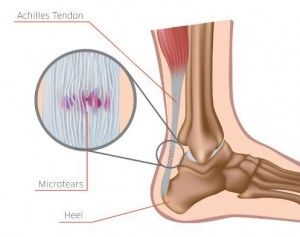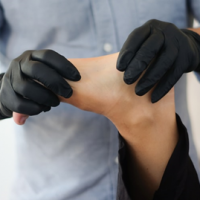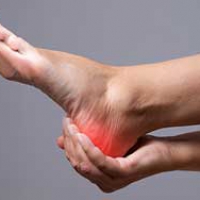
There are several factors that can cause Achille’s tendinopathy, each and every cause creating increased demands on the tendon which exceeds its physiological capabilities. Causes we see in the chiropody setting include:
- Sudden increase in activity level, decreased recovery time between activity or a combination of the two
- Poor/worn out footwear
- Activities involving sudden changes of direction and jumping such as basketball
- Biomechanical abnormalities such as over-pronation or ankle equinus
- Drastic changes in training surfaces (nature trails vs concrete cement)
Signs & symptoms of Achilles tendinopathy, which gradually develop over time or, in some situations, can be a result of an acute trauma, include:
- Pain or stiffness at the Achille’s insertion point behind the heel during or post activity
- Signs of inflammation such as redness and swelling over the Achille’s tendon
- Decreased motion and strength
Management of Achille’s tendinopathy really depends on what caused it in the first place. The chiropodist would evaluate your foot and lower limb biomechanics at rest and during gait, would evaluate and palpate the area and will get a thorough patient history in order to determine the appropriate individualized treatment plan. The treatment plan may include the following:
- Footcare advice and modifications
- Activity modification and cross-training regimens
- Rest, ice, compression and elevation to treat the inflammation
- Non-steroid anti-inflammatories such as Advil, Ibuprofen or Voltaren topical gel
- Stretching the calf muscles (eccentric calf exercises) and strengthening the surrounding ankle muscles
Temporary heel lift made out of EVA (ethyl vinyl acetate) or cork for pain relief/offloading
- Custom made foot orthotics to correct the underlying biomechanical problem (over-pronation for example)
- Physiotherapy modalities such as ultrasound and extracorporeal shockwave therapy. Extracorporeal shock wave therapy has been shown to reduce pain by 60% with a patient satisfaction of 80% (Baumbach, S. F. et al. ,2017).
- Platelet rich plasma injections can help reduce the thickness of the Achille’s tendon which can create relief in regards to tendinitis symptoms presenting an option for the treatment of chronic Achille’s tendinopathy. However, limited evidence demonstrates that platelet rich plasma injections are superior than placebo treatments in randomized controlled trials (Liu, C.-J., Yu, K.-L., Bai, J.-B., Tian, D.-H., & Liu, G.-L., 2019).
For extreme cases, there are surgical treatment options such as open or endoscopic surgeries to excise the degenerative collagen fibers, adhesions and thickened legions along with Achille’s tendon lengthening procedures and Flexor Hallucis Longus tendon transfer (Baltes, T. P. A., Zwiers, R., Wiegerinck, J. I., & Dijk, C. N. V., 2016).
One key fact to keep in mind during the treatment of any pathologies related to the Achille’s tendon is that the tendon lacks proper blood supply so this means that its healing rate can be slower than other connective tissues in the body.
Contact our clinic if you think you suffer from Achille’s tendinopathy.
Mélanie Gagnon, B.Sc D.Ch

References:
Baltes, T. P. A., Zwiers, R., Wiegerinck, J. I., & Dijk, C. N. V. (2016). Surgical treatment for midportion Achilles tendinopathy: a systematic review. Knee Surgery, Sports Traumatology, Arthroscopy, 25(6), 1817–1838. doi: 10.1007/s00167-016-4062-9
Baumbach, S. F. et al. (2017). Insertional Achilles tendinopathy : Differentiated diagnostics and therapy. Der Unfallchirurg., 120(12), 1044–1053. doi: 10.1007/s00113-017-0415-1
Liu, C.-J., Yu, K.-L., Bai, J.-B., Tian, D.-H., & Liu, G.-L. (2019). Platelet-rich plasma injection for the treatment of chronic Achilles tendinopathy. Medicine, 98(16). doi: 10.1097/md.0000000000015278
Obrien, M. (2005). The Anatomy of the Achilles Tendon. Foot and Ankle Clinics, 10(2), 225–238. doi: 10.1016/j.fcl.2005.01.011





